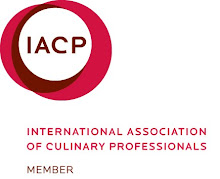
Grapes for ice wine, still frozen on the vine (Wikipedia)
I'm generally not a lover of sweet wines, but last night some delightful Canadian customers (he is a wine buyer) shared a bottle of 2006 Inniskillin Vidal Icewine with us. We drank it after dinner as a liqueur and it was delightful. Icewine would also be wonderful with foie gras or cheeses like blue cheese or gorgonzola. Its very low alcohol content (9%) enables you to enjoy several liqueur glasses without any problem.
Icewine production is fascinating. It was originally produced in Germany beginning in the late 1600's, although historian Pliny makes reference to such a wine as far back as the Roman times. Grapes that were inadvertently left on the vine were then harvested in winter and it was found that the resulting wine was a delicious, intensely sweet dessert wine.
The Niagaran Peninsula in Canada has proved to be an optimal location for the production of icewine. Grapes that mature in October are covered with a protective net and left on the vine until icewine harvest time in December or January when temperatures reach their coldest: -10 C. Harvest takes place in the middle of the night as the daytime sunshine can be enough to elevate the temperature enough to cause some defrosting.
The freezing temperatures allow for some dehydration of the grapes, adding to the concentration of sugars, natural aromas & flavors in the juice.
The yield is low (about 5 - 10% of normal) because much of the liquid is left behind in the form of ice crystals. German production is much lower than in Canada as not every year does Germany have the low temperatures necessary for icewine production. Canada, on the other hand, can count on excellent production every year.





